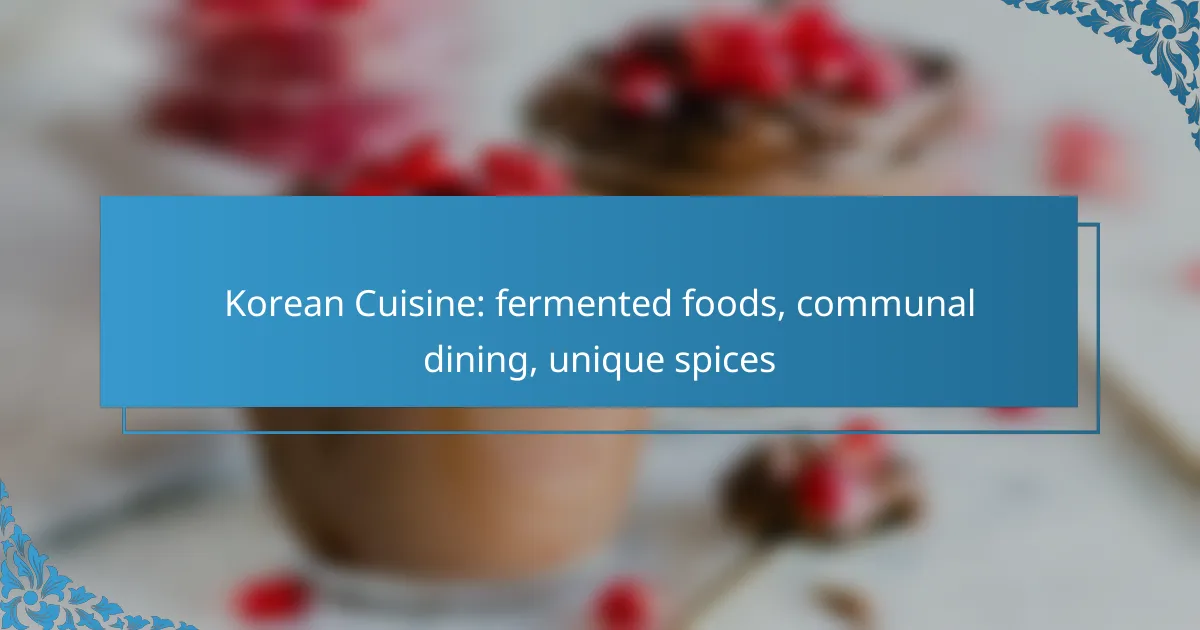Korean cuisine is renowned for its vibrant array of fermented foods, such as kimchi and gochujang, which not only offer unique flavors but also numerous health benefits. Central to the dining experience is communal eating, promoting connection and shared enjoyment among diners. The bold flavors of Korean dishes are further enhanced by distinctive spices like gochugaru and sesame oil, creating a rich tapestry of tastes that define this culinary tradition.

What are the best Korean fermented foods to try in Los Angeles?
Los Angeles offers a vibrant selection of Korean fermented foods that showcase unique flavors and health benefits. Key items to explore include kimchi, doenjang, gochujang, cheonggukjang, and makgeolli, each providing a distinct taste of Korean culinary tradition.
Kimchi
Kimchi is a staple in Korean cuisine, made primarily from fermented vegetables, most commonly napa cabbage and radishes, seasoned with chili pepper, garlic, ginger, and other spices. In Los Angeles, you can find a variety of kimchi styles, from traditional to modern twists, often available in Korean markets and restaurants.
When trying kimchi, consider the level of fermentation; younger kimchi is crunchier and fresher, while older varieties become softer and more pungent. Pair it with rice or use it as a topping for various dishes to enhance flavors.
Doenjang
Doenjang is a fermented soybean paste that serves as a fundamental ingredient in many Korean dishes, including stews and marinades. It has a rich, savory flavor that can elevate the taste of soups and sauces.
In Los Angeles, look for artisanal doenjang made from organic soybeans, which can offer a more complex flavor profile. When using doenjang, start with small amounts and adjust to taste, as it can be quite salty.
Gochujang
Gochujang is a fermented red chili paste that combines heat with a hint of sweetness, making it a versatile condiment in Korean cooking. It is commonly used in marinades, sauces, and even as a dip.
In LA, you can find gochujang in various heat levels, so choose according to your spice tolerance. It pairs well with grilled meats and can be used to add depth to stews and stir-fries.
Cheonggukjang
Cheonggukjang is a fermented soybean paste known for its strong aroma and rich flavor, often used in hearty stews. Unlike doenjang, it is fermented quickly, resulting in a distinct taste that some may find intense.
When trying cheonggukjang, consider its nutritional benefits, as it is packed with probiotics. It is best enjoyed in a hot stew with vegetables and tofu, providing a comforting meal.
Makgeolli
Makgeolli is a traditional Korean rice wine made from fermented rice, water, and nuruk (a fermentation starter). It has a milky appearance and a slightly sweet, tangy flavor, making it a refreshing drink option.
In Los Angeles, seek out local breweries that produce makgeolli, as they may offer unique variations. Serve it chilled in a bowl or glass, and pair it with savory pancakes or spicy dishes for a delightful contrast.

How does communal dining enhance the Korean dining experience?
Communal dining is central to the Korean dining experience, fostering connection and shared enjoyment among diners. This practice encourages a sense of community and enhances the overall enjoyment of meals through interaction and shared flavors.
Shared dishes
In Korean cuisine, meals typically consist of various shared dishes placed in the center of the table. This encourages diners to serve themselves and try multiple items, creating a more engaging dining experience. Common shared dishes include kimchi, bulgogi, and various banchan (side dishes), allowing everyone to sample a range of flavors.
When sharing dishes, it’s customary to use serving utensils to maintain hygiene and respect for others. This practice not only promotes a sense of togetherness but also allows for a more diverse tasting experience, as each person can choose what they prefer.
Social interaction
Communal dining naturally facilitates social interaction, making meals a time for conversation and bonding. As diners pass dishes and share food, they engage in dialogue, strengthening relationships and creating lasting memories. This interaction is often accompanied by traditional toasts and shared laughter, enhancing the overall atmosphere.
To maximize social interaction, consider inviting a diverse group of friends or family members, as different perspectives and stories can enrich the dining experience. Engaging in light-hearted discussions about the food or cultural traditions can further enhance the communal aspect of the meal.
Variety of flavors
The variety of flavors in Korean communal dining is one of its most appealing aspects. Diners can experience a wide range of tastes, from spicy to savory, all in one meal. This diversity is achieved through the combination of main dishes, side dishes, and condiments, each contributing unique flavors to the table.
To fully appreciate this variety, consider trying a traditional Korean meal that includes multiple banchan alongside a main dish. This allows you to explore different textures and tastes, making the dining experience more enjoyable and memorable. Embrace the opportunity to mix and match flavors, as this is a hallmark of Korean dining culture.

What unique spices are essential in Korean cuisine?
Korean cuisine is characterized by its bold flavors, largely attributed to unique spices that enhance dishes. Essential spices include gochugaru, sesame oil, and perilla seeds, each contributing distinct tastes and aromas that define traditional Korean meals.
Gochugaru
Gochugaru, or Korean red pepper flakes, is a staple spice in Korean cooking. It offers a mild to moderate heat level and a slightly sweet flavor, making it ideal for dishes like kimchi and stews. When selecting gochugaru, look for bright red flakes, as this indicates freshness and quality.
To incorporate gochugaru, start with a teaspoon in marinades or soups, adjusting to taste. It’s also a key ingredient in gochujang, a fermented chili paste that adds depth to many recipes.
Sesame oil
Sesame oil is a fragrant oil made from toasted sesame seeds, widely used in Korean cuisine for its nutty flavor. It is often drizzled over dishes as a finishing touch or used in dressings and marinades. When purchasing sesame oil, opt for cold-pressed varieties for the best flavor.
Use sesame oil sparingly; a little goes a long way. It can enhance stir-fries, salads, and even dipping sauces, providing a rich taste that complements other ingredients.
Perilla seeds
Perilla seeds come from the perilla plant and have a unique flavor reminiscent of mint and basil. They are often ground into a powder and used in various dishes, including soups and rice. Perilla seeds are rich in omega-3 fatty acids, adding nutritional benefits to meals.
To use perilla seeds, toast them lightly to enhance their flavor before adding to dishes. They can also be sprinkled on salads or mixed into sauces for an aromatic touch that elevates the overall taste profile.

Where can you find authentic Korean restaurants in Los Angeles?
Los Angeles is home to a vibrant Korean dining scene, offering a variety of authentic restaurants that showcase traditional flavors and communal dining experiences. From bustling Koreatown to other neighborhoods, you can find establishments that serve everything from classic dishes to modern interpretations.
Korean BBQ spots
Korean BBQ is a must-try experience in Los Angeles, where diners grill their own meats at the table. Popular spots include Kang Ho Dong Baekjeong and Park’s BBQ, known for their high-quality cuts and flavorful marinades. Expect to pay around $25 to $50 per person, depending on the selection of meats and sides.
When visiting a Korean BBQ restaurant, consider ordering a variety of meats, including beef, pork, and chicken, along with traditional banchan (side dishes). Reservations are recommended on weekends to avoid long waits.
Traditional eateries
For a taste of authentic Korean cuisine, traditional eateries like Han Bat Shul Lung Tang and Myung Dong Kyoja offer beloved dishes such as beef bone soup and handmade noodles. These restaurants often focus on family recipes and provide a cozy atmosphere for communal dining.
Prices at traditional eateries typically range from $10 to $30 per dish, making them accessible for casual dining. Look for lunch specials, which can offer great value and a chance to sample multiple dishes.
Modern fusion restaurants
Modern fusion restaurants in Los Angeles, such as Kogi BBQ and Chego, blend Korean flavors with other culinary influences, creating innovative dishes like Korean tacos and kimchi fried rice bowls. These spots appeal to a younger crowd and often feature vibrant, casual settings.
Prices at fusion restaurants can vary widely, generally falling between $10 and $25 per item. Be open to trying unique combinations that highlight Korean spices and ingredients in new ways, and check for food trucks or pop-up events for a more casual experience.

What are the health benefits of Korean fermented foods?
Korean fermented foods, such as kimchi and doenjang, offer numerous health benefits, primarily due to their rich probiotic content. These foods can enhance gut health, boost the immune system, and may even contribute to improved mental well-being.
Improved digestion
Korean fermented foods are packed with probiotics, which are beneficial bacteria that aid in digestion. Consuming these foods can help balance gut flora, leading to better nutrient absorption and reduced digestive issues like bloating and constipation.
Incorporating fermented foods into your diet can be as simple as adding a side of kimchi to your meals. Aim for a few servings each week to experience noticeable improvements in digestion.
Enhanced immune function
The probiotics found in Korean fermented foods can strengthen the immune system by promoting the growth of healthy gut bacteria. A balanced gut microbiome is crucial for a robust immune response, helping the body fend off infections and illnesses.
To support immune health, consider including a variety of fermented foods in your diet, such as kimchi, fermented soy products, and pickled vegetables. Regular consumption can lead to a more resilient immune system.
Potential mental health benefits
Emerging research suggests a link between gut health and mental well-being, often referred to as the gut-brain axis. The probiotics in Korean fermented foods may help reduce symptoms of anxiety and depression by influencing neurotransmitter production.
To explore these potential benefits, try incorporating fermented foods into your daily routine. A small serving of kimchi or a bowl of doenjang jjigae can be a delicious way to support both gut and mental health.
